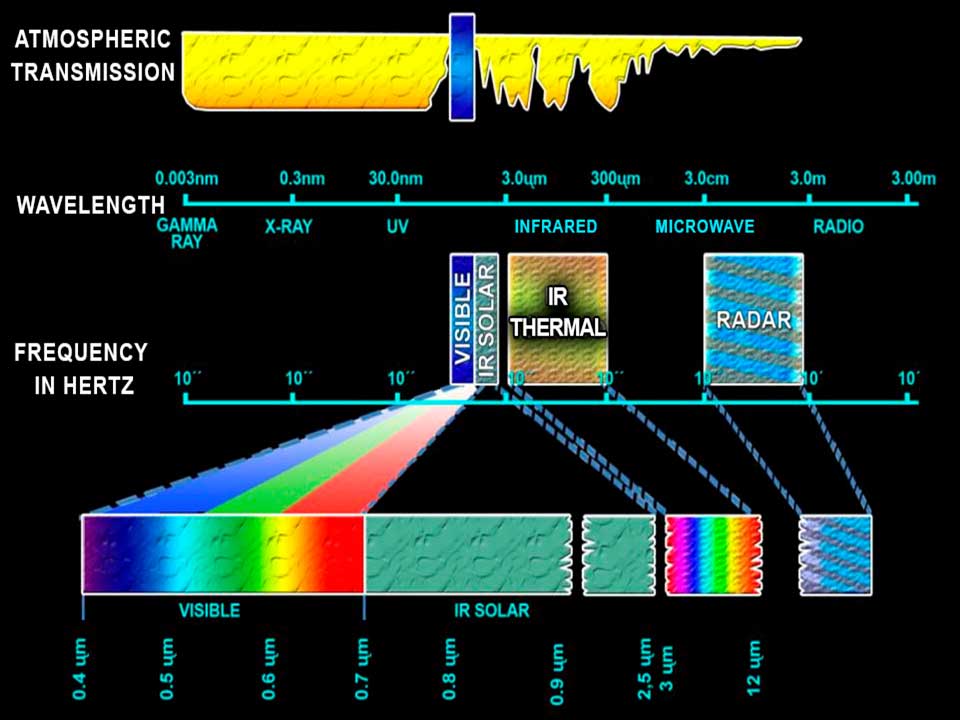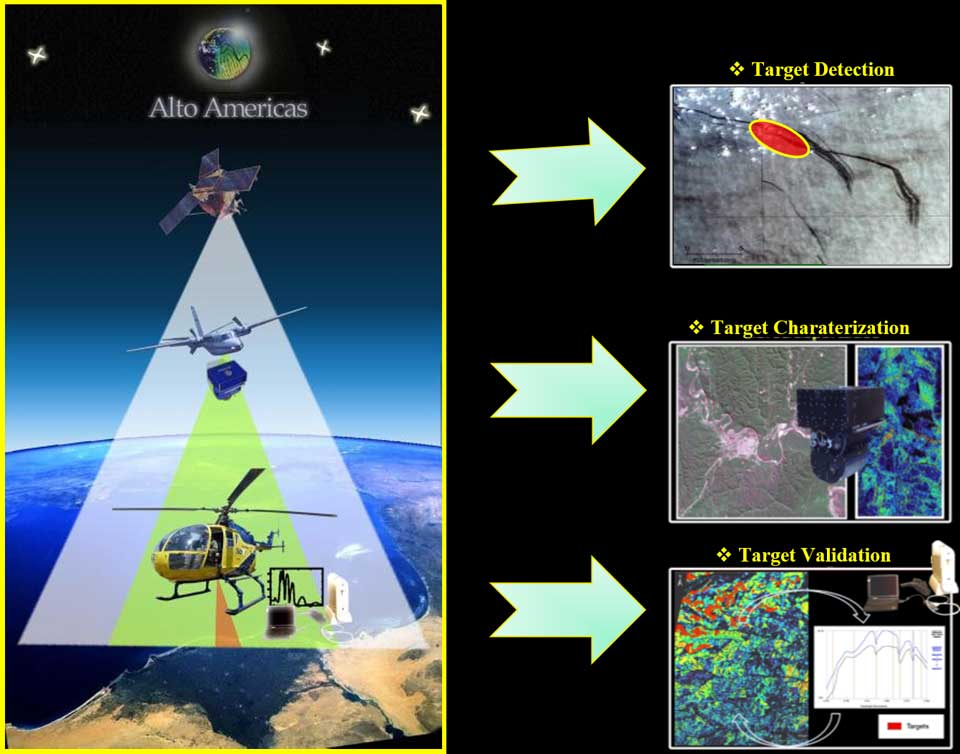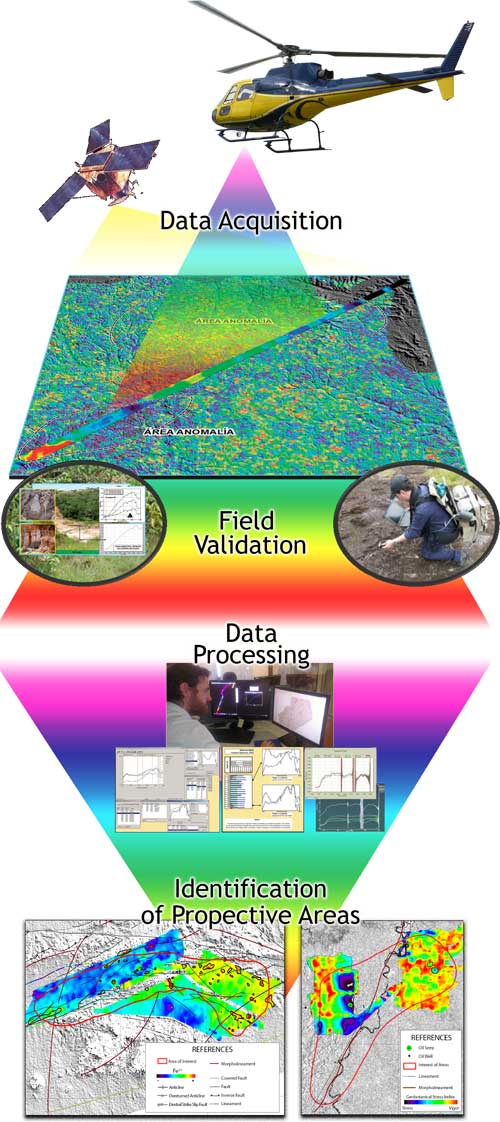
ABOUT ALTO AMERICAS
- HytecAltoAmericas is a prestigious Argentine Company dedicated to energy, mining and Oil & Gas. It is based in Argentina and it has subsidiaries in Colombia and Venezuela.
- The Company was created in the ‘90s as a technology and exploration department of ChevronTexaco (Texas, EE.UU.), and it focused on the exploration and assessment of mining and hydrocarbon projects, mainly in South America.
- In 2002, HytecAltoAmericas was acquired by its current President and majority shareholder, Dr. Guillermo Re Kühl – an Argentine geologist educated in Argentina and the United States, who has more than 30 years of professional worldwide experience.
- Since then, HytecAltoAmericas has developed a unique expertise in the use of hyperspectral and multispectral remote sensing technology (satellite, airborne and field devices), applied to the prospection and exploration for mining and Oil & Gas. The company has thus become well-known in these industries.
HytecAltoAmericas’ BACKGROUND & EXPERIENCE.
- Over 60 exploration projects carried out worldwide, using satellite, airborne and terrestrial remote sensing technologies.
- Multi and hyperspectral surveys in Argentina, Colombia, Venezuela, Uruguay, Perú, Chile, Mexico, USA., Saudi Arabia and Sudan among other countries.
- Over 25,000,000 Km2 surveyed worldwide. (Approximatelly 12 times the surface of Colombia).
HytecAltoAmericas IN COLOMBIA
- Due to our great knowledge of the Latin American market, the Board of HytecAltoAmericas decided in 2009 to bet on the potential of the Colombian market.
- Many Oil & Gas companies based in Colombia have trusted in the expertise of HytecAltoAmericas and given us the great responsibility of identifying potential hydrocarbon areas by means of our technology.
- Since late 2011, HytecAltoAmericas has also worked with the National Hydrocarbon Agency of Colombia (ANH) in the identification of hydrocarbon target areas on various basins, and, more recently, with the Geological Survey of Colombia (SGC) in the elaboration of geological mapping through remote sensing platforms.
- The work done in the country, for private companies as well as for government agencies, covers more than 70% of the Colombian territory.
Just like the human eye, remote sensors capture the light reflected on the surface of the earth. The difference lays on the fact that the “light” measured by this technology has a wider range of “colors”, many of which are invisible to the human eye. Technically speaking, the physical property that is measured by these sensors is the electromagnetic energy, which spans a wide range of wavelengths. The wavelengths that range from 400 to 700 nanometers belong to the visible spectrum, i.e. the wavelengths that can be detected by the human eye. There are ranges, though, that cannot be seen by the human eye, and those are the ones that provide the most valuable information.
This technology is based on the electromagnetic energy emitted by the sun, which is reflected after crossing the atmosphere and interacting with the earth’s surface. This interaction generates differential absorption at different wavelengths depending on the type of material it interacted with. Besides, after a certain wavelength, the intensity of the electromagnetic energy reflected by the sun becomes insignificant compared to the electromagnetic energy emitted by the Earth. This is the Thermal Infrared from the electromagnetic spectrum.

Remote Sensing surveys are carried out in different stages, each with its own objectives, types of sensors and platforms, purposes and levels of work.
The first stage involves the detection of potential prospective targets, by selecting and acquiring the available satellite imagery, mainly multispectral images with global coverage, such as LandSat (5 TM, 7 ETM+, 8 OLI), ASTER, MODIS, and radar imagery and data (SRTM, PALSAR, etc.). This procedure allows narrowing down the exploration areas within a basin, determining possible alteration areas, etc.
On the next stage, a great amount of spectral processing techniques are applied in order to obtain different kinds of product images (mineral indexes, vegetation indexes, soil coverage and uses, structures and lineaments, and topography, among others), so as to characterize the geological properties of the previously defined target.
The final stage of a project comprises the field validation of the targets by means of HytecAltoAmericas’ state-of-the-art hyperspectral remote sensors, both airborne – which can be adapted to any platform (planes or helicopters) – or portable – used on field surveys, punctual samplings and in the lab. It is possible, this way, to determine intrinsic characteristics of each target and evaluate its potential.


The integration of all the generated remote sensing data into a Geographic Information System (G.I.S.) provides an invaluable working tool for mining projects as well as for Oil & Gas.
By combining diverse remote sensing processing and interpretation techniques, it is possible to detect hydrocarbons. This can be achieved by means of direct methods, based on the spectral identification of oil seeps, and indirect methods, through the detection chemical, physical and thermal anomalies generated by hydrocarbon migration.
Physical and chemical alterations are produced on the surface, among which it is possible to identify soil anomalies and outcroppings caused by the reduction of iron oxides, kaolinization of feldspar, which is generally associated with faults and lineaments, and vegetation anomalies produced by the change in the vegetation physiologic state. Besides, hydrocarbon reservoirs are usually associated with thermal anomalies, which can be detected by analyzing temperature brightness and apparent thermal inertia.
